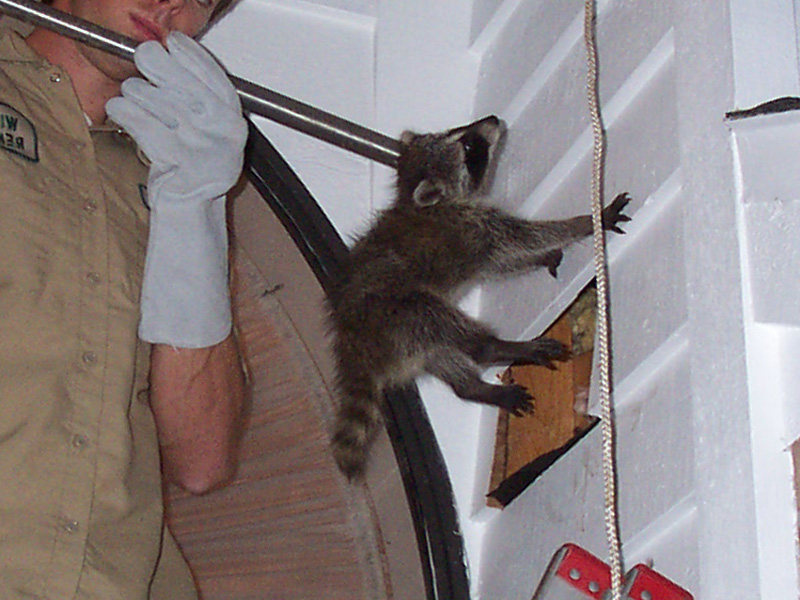- USA Wildlife Removal Education Guide and Resources
Raccoon in the Wall - What to Do

Removing A Raccoon Inside Your Wall
The majority of homes that are built with a modern construction have a small cavity between the exterior wall and the interior wall, which not only helps with soundproofing and insulating the property, but also gives a better surface to the interior wall. However, from time to time, some properties may find that animals have found their way inside these wall cavities, and they can range from rats and mice on the floor of the wall cavity up to squirrels and raccoons. The size of the cavity can also have an impact, as some raccoons will not be able to squeeze in, meaning that sometimes a baby raccoon gets stuck in the wall cavity and the parent cannot get the little one out.
Identifying That It Is A Raccoon
This is often one of the most difficult tasks without actually getting a view of the cavity somehow, but in reality being able to identify the species doesn't necessarily affect the process you follow too much. In some cases, you will be able to get a view of the wall cavity from the attic, and if this is the case it is also possible that the raccoon is getting in and out of the cavity through the attic, or it may actually have squeezed down the cavity but cannot get out again. Before trying to go into the attic to try and see into the cavity, make sure you take the same precautions as though you were actively removing the animal.
GET HELP: Do you need professional help with a raccoon problem? We have wildlife experts servicing almost every area of the USA! HIRE US IN YOUR TOWN
COSTS: You may want to read more about raccoons or the prices we charge for our services: READ ABOUT OUR RACCOON PRICES
Precautions To Take Before Trying To Remove The Raccoon
Raccoons can transmit some fairly serious diseases, including rabies through a bite, or leptospirosis through the spores that are often released when the feces of the raccoon is disturbed. Because of these risks, it is vital that you wear a breathing mask and goggles to stop you from inhaling anything, while thick clothing and gloves will reduce the chances of anything being transmitted through a bite. If you do encounter a raccoon, and it doesn't try to escape, it is best to have something like a broom to fend off the animal and prevent any contact with it.
Removing A Raccoon Trapped In The Wall Cavity
In some cases, the raccoon may be trapped in the cavity and cannot get out, and this can particularly be a problem for younger raccoons who may have slipped down but won't have the strength to climb back up again. The scratching in these instances may be quite frantic, and in most cases the only real option is to cut a hole in the wall in order to be able to get into the cavity and remove the animal. For this, you will want to have thick gloves and a cage to put the raccoon into once you get it out of the cavity, but as this is quite a tough job, in most cases it is best to leave this kind of work to the professionals and hire a wildlife removal expert.
Trapping A Raccoon That Is Getting In And Out Of The Wall Cavity
Identifying this type of situation is slightly different, and because of the habits of the raccoon, you will usually notice that the scratching noises from behind the wall are generally more intermittent. In this situation, it is important to find how the raccoons are getting in and out, and this can be through the attic, through holes or vents around ground level, or through another part of the cavity. Once you have located the exit point, a cage trap is the best option, and this should be placed over the hole, or in an area of high traffic with bait such as marshmallows to catch the raccoon as it gets in and out.
Sealing Any Access Points To The Wall
Once you have located and trapped the raccoon, if it is during the mating season you will need to identify if there are any baby raccoons in the cavity, and get those out too. Once this is done, you can seal any holes or damaged vents that the raccoon was using to get in and out, and it is important to check the area thoroughly, otherwise you may find that you get a similar problem in the future.
Cleaning Up After A Raccoon Infestation
This is less important in a wall cavity than it is in the attic, but if you have access to the cavity, it is worth checking that any wiring behind the wall hasn't been gnawed or damaged. If there is a significant amount of feces, it can also be worth cleaning this up, although make sure you take the appropriate precautions once you have done so. Using a disinfectant spray is an important part of cleaning up after the infestation, and this can really help to reduce the chances of any contamination or disease transmission from the wall cavity.
Go back to the main Raccoon Removal page for more information about what to do if you have raccoons in your walls. Do you hear scratching sounds in the walls? Is there a dead raccoon stuck in the wall cavity creating a smell or odor? Or maybe a nest of baby raccoon in the wall. Can they cause damage, and how do you get raccoon out of the wall?

